You probably already how to play an A major chord in the basic open position. Why learn more ways to play A major on baritone ukulele?
As beginners, we think of chords individually—how to play a C major, how to play an A minor, and so on. But over time, we learn to think of chords in groups that often fit together in the same patterns that appear again and again in songs. Different ways of playing the same chord allow us to play these chord groups, called chord progressions, more easily.
More ways of playing a particular chord also helps you to:
- make faster chord changes. (I explain all my tricks for faster chord changes in this article.)
- control the high note to form a melody, called chord melody or chord soloing.
- control the low note (the bass note), which gives the chord a slightlly different flavor and lets you make interesting bass lines with the low notes.
In this article we cover five different ways to play an A major chord. At the end, I’ve included an Appendix for Theory Nerds, to show where an A major chord appears in the keys that you’ll typically be using on baritone uke.
If you need to review the five basic major chord shapes in their open and moveable shapes, check out this article with lots of full-color diagrams.
Color key:
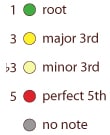
A Major – Option 1

Option 1 is the basic open position for A major on baritone ukulele.
The moveable version of this shape can be used on the 12th fret to play an A major chord:
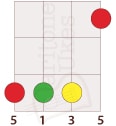
It’s helpful to realize that the moveable version of a chord shape is the same as its open position counterpart. In the open position, one or more strings is played open. To move the chord across the neck, the open strings must be fretted, and the rest of shape stays the same as you move to a higher fret.
Here is the music notation for the open position A major chord shape:
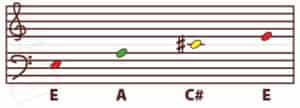
A Major – Option 2
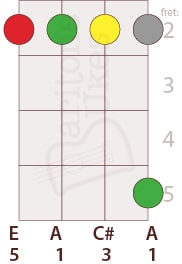
For option 2, move to the 2nd fret and use the moveable G shape to make an A major chord.
Here’s how option 2 looks in music notation:
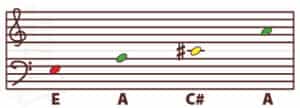
Try the move below for a quicker way to switch between A major and B minor. Your hand position and index finger remain steady while only the other fingers are moving.
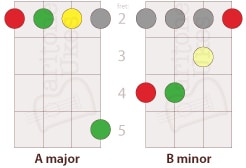
This move happens often in the key of A (switching from the I chord to the ii chord) and in the key of D (switching between the V chord and the vi).
Tip: Some chord shapes get easier as you move across the neck, because the frets get smaller. Other shapes may be easier on the bigger frets. If you’re having trouble with a chord shape, try it on different frets and practice the easiest locations first. As you gain muscle memory, you’ll find it easier to expand your range.
A Major – Option 3
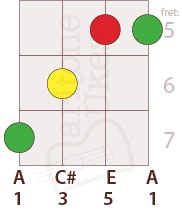
For option 3, move to the 5th fret and use the moveable E shape for another way to play an A major chord.
At first glance, you probably recognize this shape as the F shape. But if you think about it, when you use this shape on the “zero” fret, the two highest-pitch strings are played open, and the chord is an E major. In other words, an F chord is made by playing the E major shape with a bar on the first fret.
Using this shape on the 5th fret, you get the note A on the bottom of an A major chord. It is also the position for playing a root position A major chord, i.e. A-C#-E-A, i.e. 1-3-5-8.
This position is very handy when you need to swtich between E major, F major, G major, A major and B major. Just keep using the same chord shape as you slide the shape up and down the fret board like this:
zero fret – E major
1st fret – F major
3rd fret – G major
5th fret – A major
7th fret – B major
And so on. Most of the time you probably won’t want to play high up on the neck, closer to the sound hole, but you certainly can if you wish. If you keep going, you can use the same shape to continue up in pitch:
8th fret – C major
10th fret – D major
12th fret – E major
Once you get to the 12th fret, the entire sequence repeats, one octave higher in pitch.
Here’s what option 3 looks like in music notation:
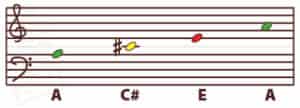
A Major – Option 4
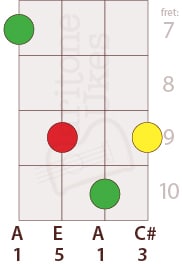
For option 4, move to the 7th fret and use the moveable D shape to play an A major chord.
Many players find this shape to be rather difficult. But even if you skip this position (you can choose option 3 or option 5 instead) it’s still helpful to understand this shape and how it fits into the sequence with the other shapes.
The sequence of the shapes is explained in more detail below. Meanwhile, notice how each shape begins where the previous shape ended.
Here is option 4 in notation:
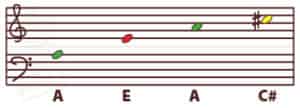
A Major – Option 5

For option 5, move to the 9th fret and use the moveable C shape to play an A major chord.
Use this shape to switch easily between A major and F# minor, a move that happens often in the key of A (from the I chord to the vi chord).
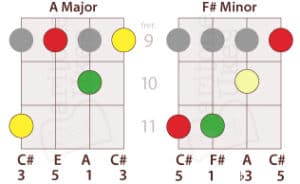
Here is what option 5 looks like in music notation:
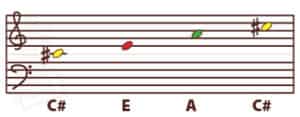
If you want to keep going higher up the neck toward the bridge, move to the 12th fret and start the sequence again with the moveable A shape.
How to remember the order of the chord shapes as you move across the neck
Let’s review the options above. To play an A major chord, use these shapes:
- open A shape – open position
- moveable G shape – 2nd fret
- moveable E shape – 5th fret
- moveable D shape – 7th fret
- moveable C shape – 9th fret
You can easily remember the order in which to use these shapes with the word CAGED. To play A major chords across the neck, start with the A shape at the “zero” fret. Then proceed up the neck with the other shapes in the order of the word CAGED. So you would get A-G-E-D-C. The sequence repeats starting on the 12th fret.
This order works for every major chord. For example, to play C major chords across the neck, start with the letter C, using the open C shape on the “zero” fret,” then continue the letters to spell the word CAGED, so you would get C-A-G-E-D.
This is called the CAGED method.
For more options for playing chords across the neck, check out my article about the CAGED method for baritone ukulele. I spent weeks on those illustrations. Hope you find them helpful!
Appendix for Theory Nerds
This chart shows you where an A major triad occurs, in terms of scale degree, in the six easiest keys for baritone ukulele.
I recommend focusing on the easiest keys for baritone uke, and using a capo if you absolutely must play in other keys.
Some ukulele and guitar teachers recommend focusing on just two keys, C major and G major. I think that’s a great idea, for starters. But for baritone ukulele, I also recommend working with the key of D, because D is the lowest note on your bari uke.
Learning those three keys, and how to use a capo, will allow you play almost popular any song. But, at the most, I would stick to the six easiest keys for baritone ukulele.
Getting back to our A major triad chord and the 5 options shown above, any particular major chord functions as a different scale degree in different keys. Like this:



0 Comments